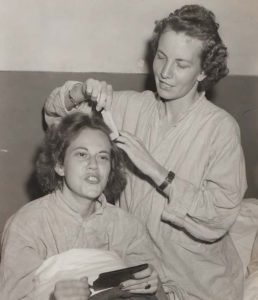Fifth in a Series of Seven Blogs about Drama in Nursing
Nurse Stereotypes in Movies
Battle Axe – One Flew Over the Cuckoo’s Nest
The battle axe nurse stereotype is the antithesis of the doctor’s handmaiden and suggests a military origin. A matronly – not to be confused with maternal – figure, her predecessors are the matrons of nineteenth-century British hospitals who as administrators had power and wielded control over the nurses, the linen room and supplies but were not involved in direct patient care on the wards. Far from resembling an angel or handmaiden, the battle axe is depicted as “tyrannical, fearsome, asexual, cruel, monstrously large, dark-clad, and set on crushing all fun and individuality’. 1 She often is pictured with a clipboard in hand. The military version of the battle axe is the “menopausal major” promoted to a managerial position in which she asserts her unbending will and commands obedience. The analogy is strengthened by the military analogies Martha Vicinus uses to describe nursing reform in London’s hospitals in the last half of the nineteenth century. Nightingale, the “supreme commander” turned over the daily operations to her ‘generals’, the matrons of the large hospitals, who in turn oversaw the work of the ward nursing sisters who were the officers in charge of the troops – the probationers and the nurses from the lower middle class. The “battle plan” emphasized cleanliness and discipline as the weapons with which to carve out a distinct space for women within the male-dominated hospital system. 2 “Matrons, like other nurses who refuse to fit the accepted stereotype of the pretty, kind, compliant nurse, are banished to the moral margins of societal acceptance where they become objects of fear or ridicule.” 3
Hollywood’s most infamous battle axe is Nurse Mildred Ratched in the 1975 film One Flew Over the Cuckoo’s Nest, based on the eponymous book by Ken Kesey. A former army nurse – in the film she wears the Army Nurse Corps insignia as well as her nursing school pin on her civilian uniform – her calm demeanor has a chilling effect and masks a contemptible female authority figure who maintains strict control over her male ‘troops’ by means of manipulative group therapy, medications and electroshock. Straight-laced and a stickler for adherence to regulations, Nurse Ratched thinks her no-nonsense approach is helping her patients, but the results of her actions suggest otherwise. As Kesey explains, “The qualities of piety and communal concern that had been taught women to keep them in their place become in her hands an instrument of power and emasculation.” 4
When faced with jail time for having had sex with a fifteen-year-old, Randle Patrick McMurphy fakes a mental illness, thinking life on a psychiatric ward the better option. Once committed, however, the free-spirited McMurphy meets his nemesis in the “wretched” Nurse Ratched, and their battle of wills fuels the action of the film. After an especially egregious misstep resulting in a brawl, McMurphy is transferred to the Disturbed Ward for a brief stay. His conversation with a nurse on that ward, found in the book but not in the film, alludes to Nurse Ratched’s battle axe behavior and to McMurphy’s eventual fate:
McMurphy told her he thought they [Warren and William, two attendants on Nurse Ratched’s ward] might be sporting some plaster the next time she saw them. She nodded and looked at her feet. “It’s not all like her ward,” she said. “A lot of it is, but not all. Army nurses, trying to run an Army hospital. They are a little sick themselves. I sometimes think all single nurses should be fired after they reach thirty-five.”
“At least all single Army nurses,” McMurphy added. He asked how long he could expect to have the pleasure of her hospitality.
“Not very long, I’m afraid.”
“Not very long, you’re afraid?” McMurphy asked her.
“Yes. I’d like to keep men here sometimes instead of sending them back, but she has seniority. No, you probably won’t be very long – I mean – like you are now.” 5
The nurse was correct; McMurphy’s final act of defiance in which he slipped two hookers onto the ward and hosted an all-night party by bribing the night attendant, then attempted to choke Nurse Ratched when her verbal confrontation with a patient found in bed with a hooker led to his suicide, resulted in a lobotomy.
The nurse as naughty is the topic of the next Blog.
To learn how the history of nursing was reflected on the opera stage, see Judith Barger, The Nurse in History and Opera: From Servant to Sister (Lexington Books, 2024).
Notes
- Darbyshire and Gordon, “Exploring Popular Images,” 79; Darbyshire, “Heroines, Hookers and Harridans,” 58.
- Vicinus, Independent Women, 92.
- Darbyshire and Gordon, “Exploring Popular Images’, 79; Darbyshire, “Heroines, Hookers and Harridans,” 58.
- Ken Kesey, One Flew Over the Cuckoo’s Nest (New York: Penguin, 1962), xviii. See also One Flew Over the Cuckoo’s Nest [1975], produced by Saul Zaentz and Michael Douglas, directed by Milos Forman, screenplay by Lawrence Hauben and Bo Goldman (Burbank, CA: Warner Home Video DVD, 2002). Louise Fletcher is Nurse Ratched.
- Kesey, One Flew Over the Cuckoo’s Nest, 240.



